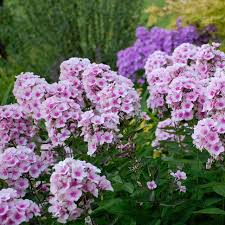
How To: Growing Phlox for Your Bees
If you are considering one particular flower for your next bee garden, Phlox would not be the worst choice. You should know that there are two forms of this particulars flower. Garden Phlox, stands around three feet. It grows upright Conversely, Creeping Phlox is more of a groundcover that that you will see in Springtime. The creeping variety is green for the majority of the year (depending on the climate you live in). Both varieties are perrenial which means you can look forward to seeing them year over year.
Creeping Phlox will bloom during mid spring - you may see it utilized often as an edging plant for gardens. Garden phlox shows it's bloom closer to July. This variety seems to be the more poppular of the two for pollinator gardens (that includes butterflies), You may also see it show up as a shrub in gardens of other perrenials. The blooms of either variety are very fragrant. Both Garden phlox and Creeping phlox produce fragrant blooms.
The Where & The When
Spring or Fall - both good times for planting Phlox. They should be planted immediately once the plant is acquired.
Light: Regardless of the variety, both types like full sun. The upright phlox can appreciate afternoon shade. You will see this tendency more frequently in southern states like the Carolinas, Georgia, Alabama, and Florida.
The Dirt: Phlox can handle most garden soils, but the soil that has adequate soil drainage is best. If you are rooted in the Northern Midwest, spring snow can drain off slowly. In this instance, the dormant roots are at risk for rotting is the soil remains damp/saturated with moisture. When this happens, just put down peat moss/compost. This will improve drainage and create more favorable growing conditions.
Mind the Gap: The ideal spacing for each Phlox plant os between 18 - 20 inches apart for Garden phlox. Creeping phlox on the other hand should be planted about 2 feet apart. You want to avoid giving rise to mildew so allowing for air circulation is of prime concern. As of this writing, you will find most of the Phlox out there is bred to resist mildew but hey, best practices are best practices.
Both varieties will gradually join together to form one big block of phlox. The Creeping variety will eventually form what can best be described as a 'carpet'.
If You Are Planting in Phlox in Autumn: You can keep your plants on your deck for a few days until planting is convenient, but don’t let the roots dry out and be sure to plant a few weeks before your first frost arrives.
Phlox in Spring: Should you get this plant in the Spring, you will most likely receive it in a container. Be sure to keep the container moist - at least until the frost is off the ground and in proper condition to receive plants. This is important for obvious reasons but remember, once the frost and snow is going, the easier the ground will be to manipulate. Frozen dirt is no one's friend.
I will do more one Phlox planting in another post. I should point out that I do not sell this particular flower. However, if you are looking for alternatives in seed form, you may consider Chrysanthemums or Lupins.
More on the how-tos of growing throughout the season in the next post

